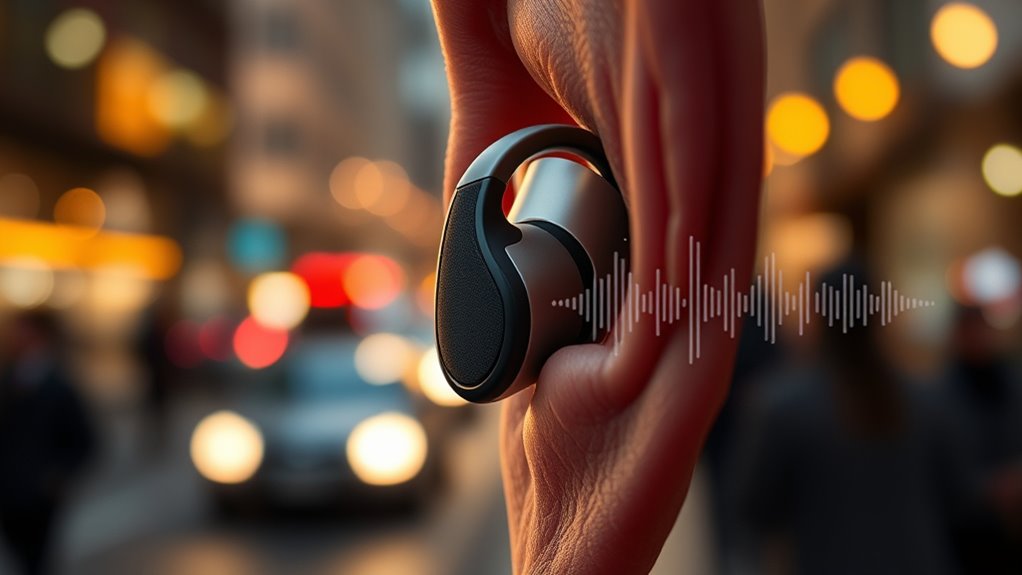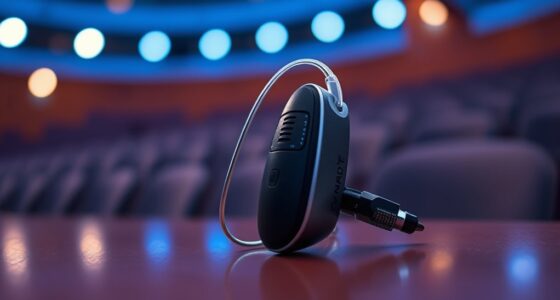Noise reduction algorithms in hearing devices use advanced signal processing to help you hear better in noisy environments. They analyze sounds in real time, separating speech from background noise with techniques like spectral subtraction and Wiener filtering. These adaptive filters adjust continuously to changing settings, ensuring speech stays clear and natural. By automatically optimizing sound, they reduce frustration and improve your listening experience. Keep exploring to discover how these algorithms can make your hearing more effortless and enjoyable.
Key Takeaways
- Noise reduction algorithms analyze audio signals in real-time to distinguish speech from background noise.
- Techniques like spectral subtraction and Wiener filtering are integrated to suppress unwanted sounds.
- Adaptive filtering continuously adjusts to environmental changes, ensuring optimal noise suppression.
- These algorithms operate seamlessly within device software to improve clarity without user intervention.
- Advanced noise reduction enhances speech intelligibility, environmental awareness, and overall listening comfort.

Have you ever struggled to hear clearly in a noisy environment? It’s a frustrating experience, but thanks to advanced noise reduction algorithms in modern hearing devices, that frustration is becoming less common. These devices use sophisticated signal processing techniques to distinguish between speech and background noise, allowing you to focus on what truly matters—conversations and sounds you want to hear. At the core of many of these algorithms is adaptive filtering, a powerful method that continuously adjusts itself to changing sound environments. Instead of relying on static settings, adaptive filters analyze incoming sounds in real-time, learning to suppress background noise while preserving speech clarity. This dynamic approach is essential because noise environments are unpredictable; what works in a quiet room won’t necessarily be effective in a bustling café or crowded street.
Signal processing techniques play an important role in making these noise reduction algorithms effective. They analyze the audio signals captured by your hearing device’s microphones, separating the desired speech from unwanted noise. Techniques like spectral subtraction and Wiener filtering are commonly employed to reduce background sounds. Spectral subtraction works by estimating the noise profile during silent moments and subtracting it from the overall signal, effectively diminishing consistent background noise. Wiener filtering, on the other hand, adapts its filtering parameters based on the statistical properties of the speech and noise signals, optimizing noise suppression without distorting the speech. These methods are integrated into the device’s software, working seamlessly to enhance your listening experience without you needing to adjust settings manually. Moreover, the use of adaptive filtering allows the algorithms to respond to rapidly changing environments more efficiently.
The beauty of adaptive filtering combined with advanced signal processing techniques is that they can respond to changing environments almost instantaneously. For example, if you move from a quiet room to a noisy street, your hearing device detects the shift and adjusts its filtering parameters accordingly. This real-time adaptation ensures that speech remains clear and intelligible, even amid loud or unpredictable noise. Additionally, these algorithms are designed to minimize artifacts or distortions that can sometimes occur during noise suppression, maintaining a natural sound quality. This seamless integration of technology means you can focus on conversations, enjoy music, or simply be aware of your surroundings without constantly fiddling with your hearing aid settings. Overall, the combination of adaptive filtering and signal processing techniques has revolutionized noise reduction in hearing devices, making them smarter and more responsive to your environment.
Frequently Asked Questions
How Do Noise Reduction Algorithms Impact Speech Clarity?
Noise reduction algorithms improve your speech clarity by enhancing the signal and reducing background sounds. They focus on boosting speech intelligibility, making conversations easier to understand in noisy environments. By filtering out unwanted noise, these algorithms allow you to focus on the speaker’s voice, resulting in a clearer listening experience. Overall, they help you hear more accurately and comfortably, especially when multiple sounds compete for your attention.
Can Noise Reduction Cause Audio Latency Issues?
Think of noise reduction algorithms as a busy traffic controller, but sometimes they cause a slight processing delay. Yes, they can create audio latency issues, affecting your hearing device’s synchronization with real-time sounds. This processing delay might make conversations feel slightly out of sync, like a dancer missing a beat. While usually minimal, this latency can impact the seamless audio experience, especially in fast-paced conversations or noisy environments.
Are Noise Reduction Features Customizable for Individual Preferences?
Yes, noise reduction features are customizable for your individual preferences. Many devices offer personalization options that allow you to modify settings based on your hearing needs and environment. You can often perform user adjustments through dedicated apps or device controls, giving you control over the level of noise reduction. This ensures you get a comfortable listening experience tailored specifically to your preferences and daily situations.
How Do Algorithms Differentiate Between Background Noise and Speech?
Algorithms differentiate between background noise and speech by using spectral filtering and machine learning. Spectral filtering analyzes the sound frequencies, isolating speech patterns from noise. Meanwhile, machine learning models learn to recognize speech characteristics over time, improving accuracy. So, when you’re in a noisy environment, your hearing device actively filters out unwanted sounds while focusing on speech, giving you clearer conversations and a more natural listening experience.
What Are the Limitations of Current Noise Reduction Technology?
You might find current noise reduction technology limited by its ability to fully suppress background noise without affecting speech clarity. Background noise suppression can sometimes remove important sounds, and the algorithms struggle with highly dynamic environments. Although algorithm adaptability improves over time, it still can’t perfectly distinguish between noise and speech in all situations. As a result, you may experience reduced effectiveness in noisy, unpredictable settings, impacting your overall hearing experience.
Conclusion
So, after all these advanced noise reduction algorithms, you’d think hearing devices would be perfect. But ironically, even with all this technology, some sounds still slip through, reminding you that no matter how smart the algorithms get, they’re not quite magic. You might still find yourself yearning for silence, only to realize that the quest for perfect hearing is an ongoing battle. Sometimes, technology’s greatest feat is simply making noise tolerable—not entirely gone.











